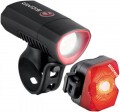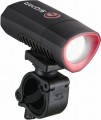Type
The type determines the purpose and configuration of the lantern.
— Velofara. A device similar to car headlights and designed to illuminate the road in front of the cyclist, as well as to increase its visibility. In many countries, the use of a bicycle headlight at night or in low visibility conditions is mandatory; and even if there is no such prescription in the law, driving without lights in poor visibility is simply unwise and unsafe. The headlight, usually, is mounted on the steering wheel and rotates with it; many of these devices have a strobe mode to further improve visibility.
—
Flasher. Auxiliary lamp mounted at the rear of the bicycle. Usually, flashing lights are made red (although there are other colours) and are not intended for lighting, but solely to make the cyclist more visible to other road users. Unlike headlights, such equipment is rarely mandatory even at night, however, from the point of view of traffic safety, it is much more effective and preferable than simple reflectors (reflectors). Note that, despite the name, flashers do not necessarily work only in flashing mode — usually, the design also provides for a constant light mode.
—
Velofara + flasher. A kit that includes both of the devices described above — a bicycle headlight and a flasher. The point of this option is that the cyclist can purchase both the front and rear lights at once, instead
...of buying them one at a time. On the other hand, buying separately gives you the opportunity to choose the lights at your discretion, while in this case you have to rely on the decision of the manufacturer. Therefore, the “bicycle headlight + flasher” kits have not received much distribution.LED
The number of individual light emitting diodes (LED) installed in the flasher (see "Type").
A flasher does not require high brightness, so several LEDs are usually installed in such lights based on specific operating modes: for example, a pair of LEDs can flash alternately, several in a row provide the effect of “running lights”, etc. At the same time, one LED is enough for use for its main purpose.
Visibility of flashing
The distance at which the flasher (see "Type") remains visible. This is one of the key parameters for this type of lamps, because. flashers were originally designed to be used as signaling devices for others. However, it is worth noting that manufacturers indicate “perfect” visibility indicators in the specifications, while real ones can be noticeably lower — for example, in a dense traffic in the light of city lights, even a flashing lamp will not attract attention as much as on an unlit country road at night. Therefore, it is worth evaluating this indicator with a significant adjustment for the described difference.
Operating modes
The number of operating modes provided in the flasher (see "Type").
The presence of two modes, usually, means the ability to work in constant light mode — in some cases this format is considered more preferable (although the blinking is still more noticeable). And if there are more than two modes, then the flasher also provides more specific options (for example, “running lights”).
Power source
The type and number of batteries used by the bike light.
All elements, except for the proprietary batteries (see below), are removable and, usually, quickly replaced; many of them are available in two versions — disposable batteries and rechargeable batteries. The advantage of batteries is their low cost, but they need to be bought regularly; batteries are noticeably more expensive, but once you buy a kit and a charger, you will no longer need to spend money on batteries.
—
AA. One of the most popular modern standard sizes. However, in bicycle lights, such elements are used infrequently — in particular, because of the relatively large size. There are many brands of AA batteries on the market, differing in capacity and, accordingly, operating time.
—
AAA. A smaller version of the AA battery described above. Due to their compact size, they are well suited for bicycle lights; and the capacity of such batteries, although rather low, is quite sufficient, taking into account the specifics of use (flashing lights most often do not have significant power consumption).
—
CR2032. One of the most popular and largest types of coin batteries, with a diameter of 20 mm and a thickness of 2.3 mm. At the same time, compared to cylindrical cells (like AA), the dimensions of such batteries are very compact, which, combined with good capacity sp
...ecs, makes them very convenient for flashing lights. Typically, CR2032 cells are sold as disposable batteries.
— CR1025. Another type of coin battery is 10 mm in diameter and 2.5 mm thick. Due to their smaller size, they are noticeably inferior to RS2032 in terms of capacity, which is why they are used very rarely — mainly in flashing lights of low brightness, created with an emphasis primarily on compactness.
— LR44. Coin batteries (usually disposable) with a diameter of 11.6 mm and a thickness of 5.4 mm. The features are similar to those described above CR1025 but they are even rarer.
— LR01. Also known as LR1 or N. They are produced mainly in the form of disposable batteries, they are cylindrical, 30.2 mm long, and 12 mm in diameter (thus, LR01 is shorter than AAA, but noticeably thicker). Such batteries are considered optimal for devices with high current consumption. However, such devices are relatively rare among bicycle lights, and therefore LR01 has not received much distribution.
— 18650. Elements are usually made in the form of lithium-ion rechargeable batteries. Similar in shape to the AA battery, but larger, with higher capacity, and a higher voltage of 3.7V. 18650 cells are designed for high-power devices; therefore, in the case of bicycle lights, such power is a sign of a high-end model, with very high brightness levels and a long battery life. There are few such models on the market.
— Proprietary rechargeable batteries. This category includes all proprietary batteries that do not belong to any of the standard sizes, and often non-removable ones. In the case of bicycle lights, the convenience of the battery lies in the fact that it is immediately supplied in the kit. On the other hand, such a battery in the event of a discharge cannot be quickly replaced with a new one. However, the battery life is usually quite decent, and this disadvantage can hardly be considered significant; with careful attention and regular charging, it is reduced to almost zero.Mount
—
Rigid mount. The mechanism for installing a bicycle lamp (flashing lights) on the frame or handlebars of a bicycle. Rigid design limits mounting space, but contributes to high reliability and a tenacious grip, as a result of which even aggressive riding will not lead to loss of the accessory.
—
Flexible mount. The method of fastening the device in the manner of a strap in a wrist watch. This method is more versatile, since it can capture not only the frame, but also a helmet, boot, etc. But in reliability it is inferior to the rigid mount described above.
—
Helmet mount. A variant of mounting a bicycle lamp on a cyclist's helmet. This is achieved thanks to special ventilation slots in the helmet and fastening fasteners on the harnesses. It is worth noting that this type of mount is found mainly in addition to the main rigid one, however, there are models where this is the only way to install a bicycle lamp.
Quick release mount
The presence of a mount that allows you to quickly remove the bike light and put it back. This can be either a mount on the body of the lamp itself, or a base that is constantly on the bicycle, to which the lamp is attached using a latch, magnet or other similar device. Anyway, the convenience
of a quick-release mount is obvious: the flashlight can be removed (for example, to replace batteries, repair, or to avoid theft from a “tied” bike) in just a couple of seconds, and without the use of special tools.

